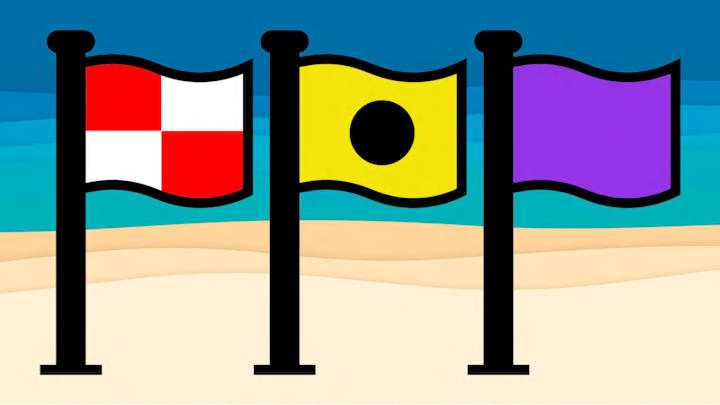Thanks to traffic lights and other color-related customs both on and off the road, we’ve been primed to think green means “go” and red means “stop” (unless they’re together, which means “Christmas”). So you may already have intuited that a green flag on the beach signals that everything’s OK, while a red flag indicates dangerous conditions.
But what exactly are those conditions—and how is a regular red flag different from a double red flag, or a red and yellow flag? Also, what should you do if a black and white flag looms over your favorite stretch of sand?
Here’s a handy guide to 11 flags you could encounter during your next beach day.
1. Green

Though a green flag indicates calm conditions, there’s a reason it’s considered the “low hazard” flag rather than a “no hazard” one. “The ocean is always unpredictable, and even on clear and calm days, hazards still exist,” USA TODAY explains. You should always “exercise caution in the ocean, listen to lifeguard warnings, and keep a close eye on children.”
2. Yellow

Yellow indicates “medium hazard,” meaning waves are a bit rougher and there could be rip currents. Weak swimmers should either stay out of the water or wear life jackets. Beaches with permanent hazards like slippery rocks or a sudden drop-off might always fly a yellow flag.
3. Red

A red flag means “high hazard,” so expect big waves and/or strong currents. You’re technically allowed to swim, but only skilled swimmers should do so (and with the utmost caution).
4. Double Red

If you see a red flag above another red flag, however, conditions are so hazardous that nobody’s allowed in the ocean.
5. Red Over Yellow

It’s good to set your stuff down near a half red, half yellow flag: It simply means the area is supervised by lifeguards.
6. Purple or Blue

A purple or blue flag indicates the presence of dangerous marine pests, like jellyfish or stingrays. Swimming is still permitted, but do so at your own risk.
7. Black Circle on Yellow

A black circle on a bright yellow flag means surfboards and other non-powered watercraft are forbidden in the area; it’s for swimming only.
8. Black and White

A quartered black and white flag, on the other hand, indicates a surfing zone. Surfboards and other non-powered watercraft are welcome, while swimmers should steer clear.
9. Red and White

If a lifeguard raises a quartered red and white flag, evacuate the ocean immediately. This could be due to a shark sighting, inclement weather, water contamination, or some other emergency that might make the water unsafe.
10. Orange Windsock

An orange windsock means you’re not allowed to bring inflatables into the ocean because powerful offshore winds (which blow from land to sea) are present.
11. Multicolored Ring on Black
The latest addition to the beach advisory lineup is a multicolored ring on a black flag—a design meant to resemble a melanoma. This so-called “sun warning flag” or “sun safety flag,” created by German Cancer Aid and other organizations, reminds beachgoers to check the UV index scale on the flagpole. If it’s red or purple, they should stay in the shade and be especially diligent about wearing sunscreen. The flag was submitted to the International Organization for Standardization last year, and it remains to be seen whether it’ll become a mainstay on beaches around the globe.
